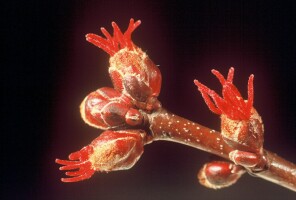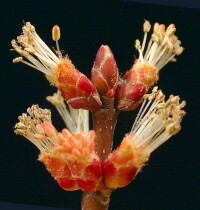Silver Maple
(Click on links for additional photos.)
One of the first signs of spring is a native woodland flower so early that it is often overlooked. Don’t look down at the ground for this flower, look up; this is not one of our dainty spring perennials, it’s a good-sized tree!
The exact date that the Silver Maple blooms varies with weather and location. It blooms as early as February in the South and as late as May in the northern extremes of its range, but here in the Finger Lakes area, it usually blooms in March. Early in spring, long before the trees begin to leaf out, even before the pussy willow's catkins, you may notice a haze of red among the branches of the Silver Maples. Look closely and you will see that it is made up of hundreds and thousands of reddish buds swelling along the branches. One day, when the weather is just perfect, all the flower buds on the Silver Maple will burst into bloom at once. In fact, all the Silver Maple flowers in the neighborhood will bloom together, within a few days of each other. Look quickly because the blooms won’t last long.
They don’t look the way you expect a flower to look; they look like little red (or red and yellow) pom-poms. They are red versions of the fuzzy yellow flowers of the Cornelian Cherry (Cornus mas) or Spicebush (Lindera benzoin). Like these, maples are wind-pollinated and don’t need showy petals to attract insects, so on Silver Maple flowers there are no noticeable petals. The flowers are generally either male or female and what you are seeing are bundles of stamens, sometimes red and sometimes yellowish-green, tipped with yellow pollen (the male flowers); or reddish clusters of pistils (the female flowers) forming clumps of bristly little balls along the branches. The pistils develop petal-like extensions at the tips; these are the stigmas, receptors for the pollen. Most of the flowers on any given tree are of the same gender, so there are male trees and female ones.If it is windy (and when is it not windy in March?), the wind soon blows the pollen away, and within a day or so the male flowers start to turn brown and droop. The female flowers seem to bloom much longer, but after they are pollinated, the stigmas also droop, turn brown, and fall off. From a distance, the trees still seem to be in bloom; but if you look closely, you will see that you are now looking at clusters of fruit instead of flowers. The developing seeds are also red at first, so the fruit clusters look much like the flowers and the female trees seem to bloom for weeks.
Silver maples have some of the largest seeds of our native Maples. (The dry, winged fruits are called "keys" or "samaras" in botanical jargon; or, because they are double, "schizocarps" in even more incomprehensible jargon.) The fruits eventually turn green, then brown, and become the typical two-winged seeds that we associate with maples, twirling like gyrocopters as they fall from the trees by the thousands in late May or early June; but by then the leaves have obscured the branches and we have many and showier spring flowers to distract our attention.
Read on to Mark's Silver Maple Fact Sheet for more pictures and additional information.
About
By Mark D. Inglis
Photos by Dave Spier except photo of male flowers by Dan Otis




